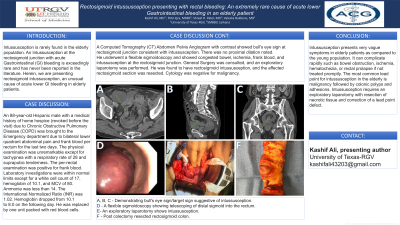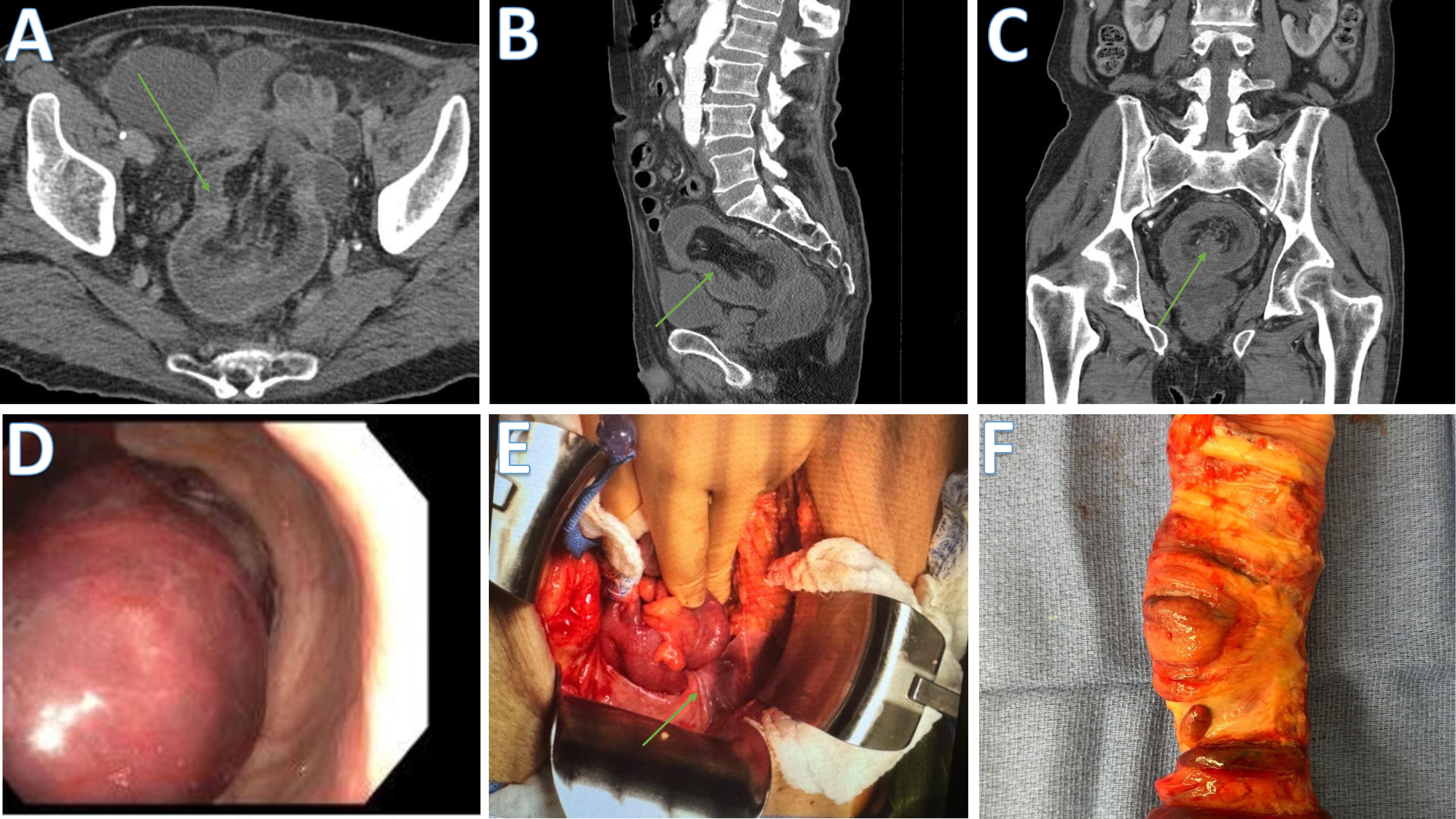Tuesday Poster Session
Category: GI Bleeding
P4188 - Rectosigmoid Intussusception Presenting With Rectal Bleeding: An Extremely Rare Cause of Acute Lower Gastrointestinal Bleeding in an Elderly Patient
Tuesday, October 29, 2024
10:30 AM - 4:00 PM ET
Location: Exhibit Hall E

Has Audio

Kashif Ali, MD
University of Texas Rio Grande Valley
Edinburg, TX
Presenting Author(s)
Kashif Ali, MD1, Fnu Iqra, MBBS2, Shreel H. Patel, MD3, Valeska Balderas, MD4
1University of Texas Rio Grande Valley, Edinburg, TX; 2Shaheed Mohtarma Benazir Bhutto Medical University, Larkana, Sindh, Pakistan; 3University of Texas Rio Grande Valley - Knapp Medical Center, Weslaco, TX; 4Texas Gastroenterology Institute, McAllen, TX
Introduction: Intussusception is rarely found in the elderly population. An Intussusception at the
rectosigmoid junction with acute Gastrointestinal (GI) bleeding is exceedingly rare and has
never been reported in the literature. Herein, we are presenting rectosigmoid
intussusception, an unusual cause of acute lower GI bleeding in elderly patients.
Case Description/Methods: An 88-year-old Hispanic male with a medical history of home hospice (revoked before the
visit) due to Chronic Obstructive Pulmonary Disease (COPD) was brought to the
Emergency department due to bilateral lower quadrant abdominal pain and frank blood per
rectum for the last two days. The physical examination was unremarkable except for
tachypnea with a respiratory rate of 28 and suprapubic tenderness. The per-rectal
examination was positive for frank blood. Laboratory investigations were within normal
limits except for a white cell count of 17, hemoglobin of 10.1, and MCV of 80. Ammonia was less
than 14. The International Normalized Ratio (INR) was 1.02. Hemoglobin dropped from 10.1
to 8.0 on the following day. He was replaced by one unit packed with red blood cells. A
Computed Tomography (CT) Abdomen Pelvis Angiogram with contrast showed bull's eye sign at
rectosigmoid junction consistent with intussusception. There was no proximal dilation noted.
He underwent a flexible sigmoidoscopy and showed congested bowel, ischemia, frank blood, and
intussusception at the rectosigmoid junction. General Surgery was consulted, and an exploratory laparotomy
was performed. He was found to have rectosigmoid intussusception, and the affected rectosigmoid section
was resected. He was sent back home to hospice due to advanced COPD.
Discussion: Intussusception presents very vague symptoms in elderly patients as compared to the
young population. It can complicate rapidly such as bowel obstruction, ischemia,
hematochezia, or rectal prolapse if not treated promptly. The most common lead point for
intussusception in the elderly is malignancy followed by colonic polyps and adhesions.
Intussusception requires an exploratory laparotomy with resection of necrotic tissue and
correction of a lead point defect.

Disclosures:
Kashif Ali, MD1, Fnu Iqra, MBBS2, Shreel H. Patel, MD3, Valeska Balderas, MD4. P4188 - Rectosigmoid Intussusception Presenting With Rectal Bleeding: An Extremely Rare Cause of Acute Lower Gastrointestinal Bleeding in an Elderly Patient, ACG 2024 Annual Scientific Meeting Abstracts. Philadelphia, PA: American College of Gastroenterology.
1University of Texas Rio Grande Valley, Edinburg, TX; 2Shaheed Mohtarma Benazir Bhutto Medical University, Larkana, Sindh, Pakistan; 3University of Texas Rio Grande Valley - Knapp Medical Center, Weslaco, TX; 4Texas Gastroenterology Institute, McAllen, TX
Introduction: Intussusception is rarely found in the elderly population. An Intussusception at the
rectosigmoid junction with acute Gastrointestinal (GI) bleeding is exceedingly rare and has
never been reported in the literature. Herein, we are presenting rectosigmoid
intussusception, an unusual cause of acute lower GI bleeding in elderly patients.
Case Description/Methods: An 88-year-old Hispanic male with a medical history of home hospice (revoked before the
visit) due to Chronic Obstructive Pulmonary Disease (COPD) was brought to the
Emergency department due to bilateral lower quadrant abdominal pain and frank blood per
rectum for the last two days. The physical examination was unremarkable except for
tachypnea with a respiratory rate of 28 and suprapubic tenderness. The per-rectal
examination was positive for frank blood. Laboratory investigations were within normal
limits except for a white cell count of 17, hemoglobin of 10.1, and MCV of 80. Ammonia was less
than 14. The International Normalized Ratio (INR) was 1.02. Hemoglobin dropped from 10.1
to 8.0 on the following day. He was replaced by one unit packed with red blood cells. A
Computed Tomography (CT) Abdomen Pelvis Angiogram with contrast showed bull's eye sign at
rectosigmoid junction consistent with intussusception. There was no proximal dilation noted.
He underwent a flexible sigmoidoscopy and showed congested bowel, ischemia, frank blood, and
intussusception at the rectosigmoid junction. General Surgery was consulted, and an exploratory laparotomy
was performed. He was found to have rectosigmoid intussusception, and the affected rectosigmoid section
was resected. He was sent back home to hospice due to advanced COPD.
Discussion: Intussusception presents very vague symptoms in elderly patients as compared to the
young population. It can complicate rapidly such as bowel obstruction, ischemia,
hematochezia, or rectal prolapse if not treated promptly. The most common lead point for
intussusception in the elderly is malignancy followed by colonic polyps and adhesions.
Intussusception requires an exploratory laparotomy with resection of necrotic tissue and
correction of a lead point defect.

Figure: A, B, C - Demonstrating bull's eye sign/target sign suggestive of intussusception.
D - A flexible sigmoidoscopy showing telescoping of distal sigmoid into the rectum.
E- An exploratory laparotomy shows intussusception.
F - Post colectomy resected rectosigmoid colon.
D - A flexible sigmoidoscopy showing telescoping of distal sigmoid into the rectum.
E- An exploratory laparotomy shows intussusception.
F - Post colectomy resected rectosigmoid colon.
Disclosures:
Kashif Ali indicated no relevant financial relationships.
Fnu Iqra indicated no relevant financial relationships.
Shreel Patel indicated no relevant financial relationships.
Valeska Balderas indicated no relevant financial relationships.
Kashif Ali, MD1, Fnu Iqra, MBBS2, Shreel H. Patel, MD3, Valeska Balderas, MD4. P4188 - Rectosigmoid Intussusception Presenting With Rectal Bleeding: An Extremely Rare Cause of Acute Lower Gastrointestinal Bleeding in an Elderly Patient, ACG 2024 Annual Scientific Meeting Abstracts. Philadelphia, PA: American College of Gastroenterology.

